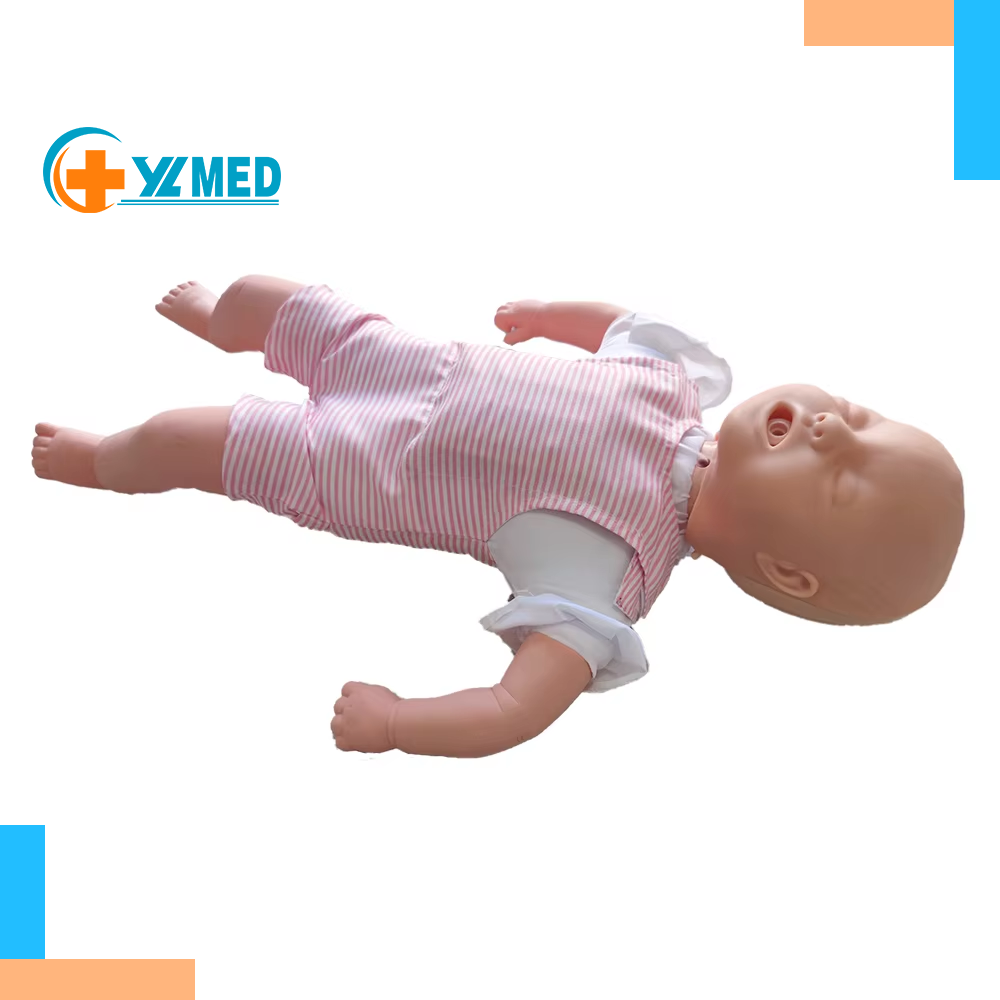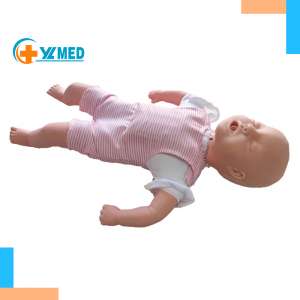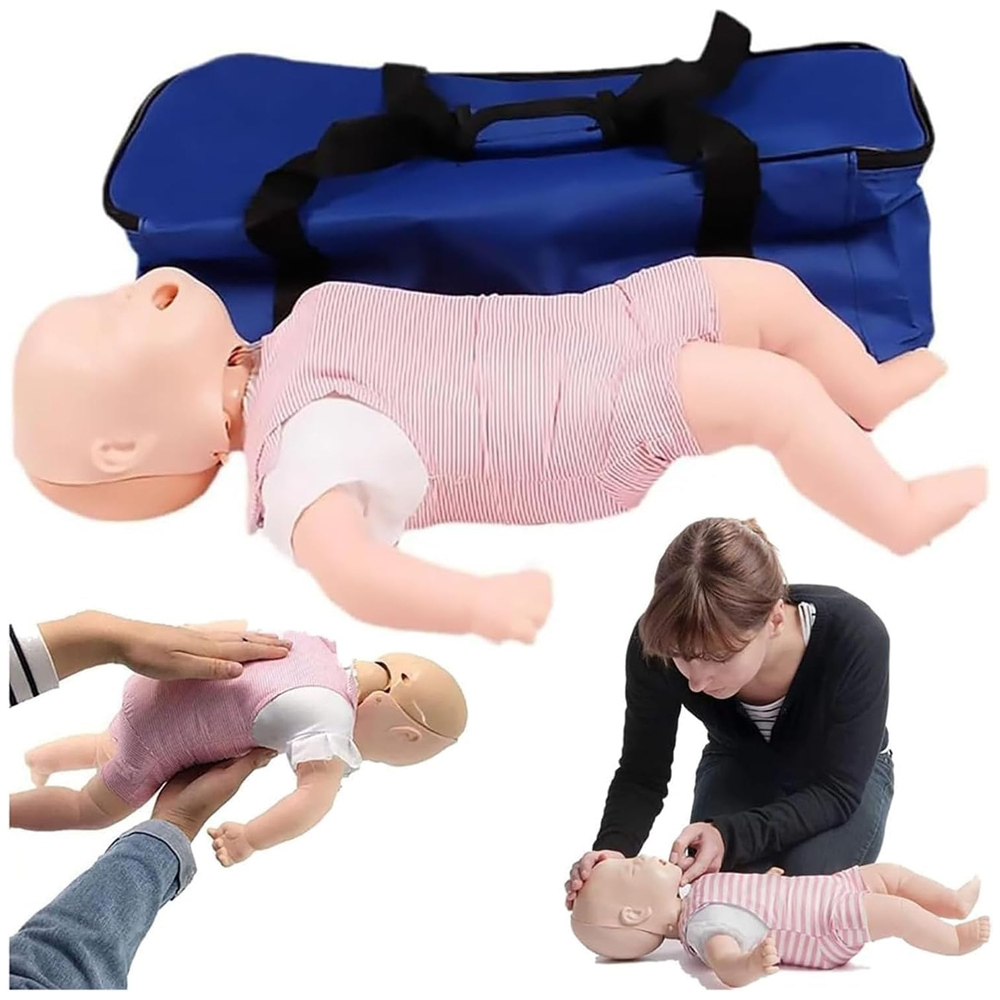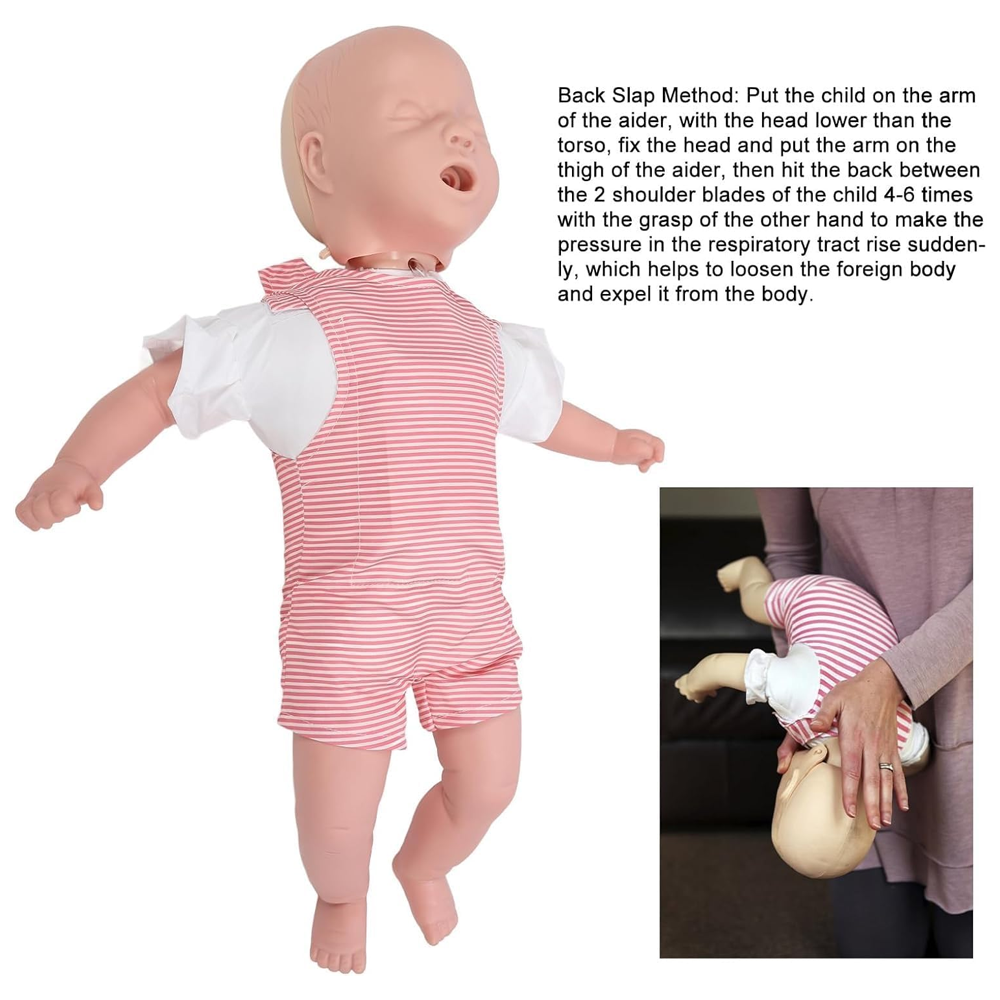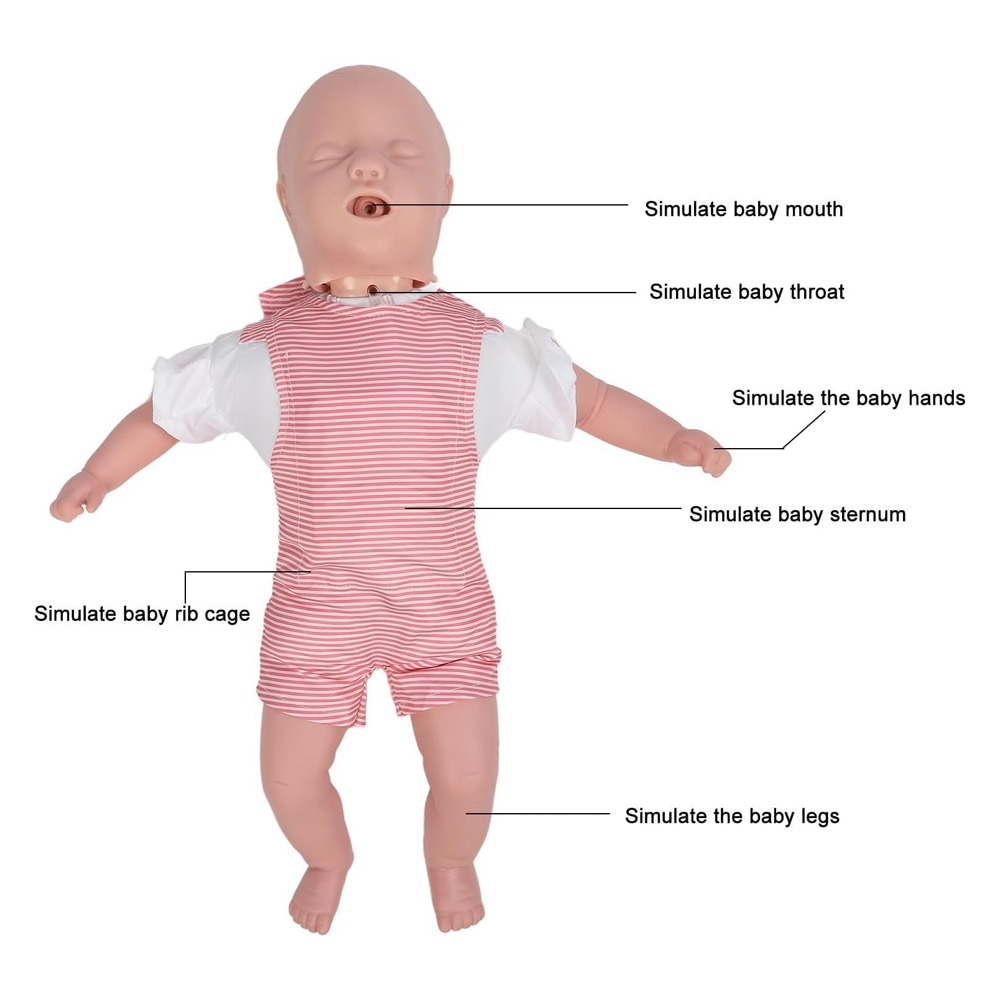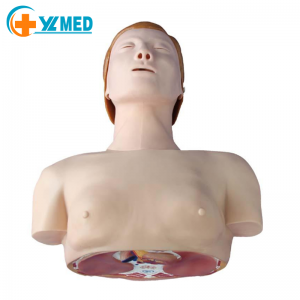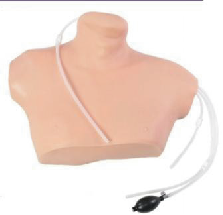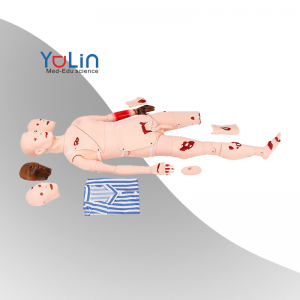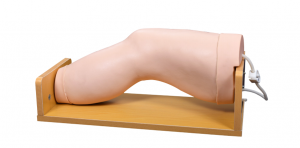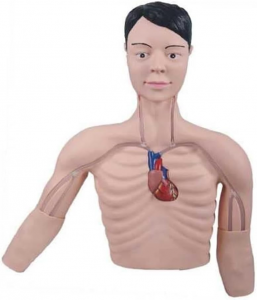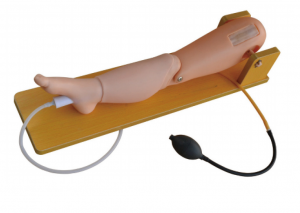Medical teaching nursing Infant Obstruction Mode
Medical teaching nursing Infant Obstruction Mode
1.The product is designed for practicing Heimlich maneuver.The manikin is designed according to infant anatomic and physiological
characteristics and suitable for airway foreign body emergency.Airway foreign body is common in infant and children.Infant and children
due to immature epiglottal cartilage and unsound function,it is easy to inhale the contents into trachea,if they speak,cry,laugh and do
active activities with contents in the mouth,it would cause airway obstruction and choking.
1)Back blow method:let patient ride and pronate on the rescuer’s arm with head lower than trunk,fix head and put his arm on rescuer’s
thigh,then blow patient back forcefully 4-6 times with the other han,so that a sudden increase in airway pressure can help loosen
anddischarge the foreign body.
2)Chest-thrust method:Let patient in supine position and hold in rescuer’s arm,with head a little lower than trunk;press the middle part
between two nipples 4-6times with two fingers.When necessary,the two methods can be interchangeably used until the foreign body is
discharged or patient loss consciousness.
Features:
1.Artificial respiration and external chest compression;
2.Simulation of natural airway;
3.Airway opening and chest compression;
4.Chest rise when airway opened;
5.Simulation of foreign-body airway obstruction.
# Infant Airway Infarction Cardiopulmonary Resuscitation Training Model – A Practical Mentor to Safeguard Infant Life
Product Introduction
This infant airway obstruction cardiopulmonary resuscitation training model is strictly designed based on the anatomical features and physiological characteristics of infants. It accurately simulates critical scenarios such as airway obstruction and asphyxia, assisting medical staff, first aid trainers, and parenting professionals in mastering key infant first aid skills proficiently and laying a solid practical foundation for safeguarding the lives and safety of infants.
Core functions
1. Realistic scene simulation
- ** Airway Obstruction Reduction ** : Precisely present the tracheal obstruction state of infants caused by the immaturity of the epiglottis cartilage and the inhalation of foreign objects, simulate the facial color changes and airway obstruction signs during asphyxia, allowing trainers to directly identify the danger.
- **CPR Operation Adaptation ** : Supports standard infant cardiopulmonary resuscitation operations, including external chest compression, artificial respiration (mouth-to-mouth, mouth-to-nose, etc.), compression depth, air volume and other parameters, in line with the American Heart Association (AHA) emergency guidelines. Electronic monitoring of compression frequency, depth, air volume and tidal volume, and real-time feedback on the correctness of the operation.
2. Diversified first aid training
- ** Heimlich Maneuver Practical ** : When simulating a foreign body obstruction in an infant’s airway, training can be carried out with the back tapping method and the chest finger strike method. The trainer masters the core skills of Heimlich maneuver through correct posture and force operation, sensing the changes in airway pressure and the simulation feedback of foreign body expulsion.
- ** Comprehensive First Aid Process ** : It connects airway obstruction identification, first aid operations (Heimlich maneuver, CPR), and subsequent care, recreating a real first aid scene and enhancing the trainee’s on-the-spot handling ability. From identifying the danger to effective rescue, it forms a complete skill loop.
3. Durable and portable design
- ** Reliable material ** : Made of medical-grade materials such as thermoplastic elastomer mixed glue, the skin is soft and elastic, and the anatomical structure is clear (the sternum, ribs, etc. can be felt). After frequent compression, puncture and other operations, it is not easy to break or deform, ensuring long-term stable use.
- ** Flexible and portable ** : The model size is in line with the proportion of an infant’s body, with a moderate weight. Combined with a portable storage solution, it is convenient for scenarios such as teaching transportation in schools, rural training in medical institutions, and community first aid science popularization. Practical training can be carried out anytime and anywhere.
Applicable scenarios
1. Medical education and training
- ** College Classroom ** : In the teaching of nursing and clinical medicine majors, teachers use models to demonstrate the first aid process for infant airway infarction. Students practice in groups, from theoretical explanations to simulated first aid, to consolidate the foundation of professional skills and reserve the ability for clinical internships and work.
- ** Pre-job Training for Medical staff ** : Training for newly recruited pediatric medical staff and emergency personnel in medical institutions. Through repeated model practice, it standardizes operation details (such as pressing positions and Heimlich force application points), strengthens muscle memory, and improves the level of clinical emergency response.
2. First Aid science popularization and community education
- ** Community Lecture ** : The community held a science popularization activity on infant and toddler safety. First aid instructors demonstrated the first aid methods for airway obstruction with models and invited parents to participate in practical operation experiences. From identifying the risk of infants inhaling foreign objects to learning the correct first aid actions, enhancing the family’s emergency response capabilities, and safeguarding the safety of infants and toddlers in the community;
- ** Childcare Institution Training ** : Childcare centers provide first aid skills training for caregivers. They use models to simulate scenarios such as infants choking while eating and inhaling foreign objects while playing, enabling caregivers to master first aid skills and reduce the risk of accidents during the childcare process.
3. Medical Assessment and Skills Competition
- ** Skills Assessment ** : As a tool for medical skills assessment, colleges and medical institutions can set up standardized assessment procedures for emergency treatment of infant airway infarction. Through model monitoring of operation data (compression depth, blowing effectiveness, etc.), the skill levels of trainees and medical staff can be objectively evaluated.
- ** Competition Drill ** : In the first aid skills competition, the model creates a realistic and tense first aid scene. Participants need to quickly identify the infarction state and accurately perform first aid operations, testing their on-the-spot adaptability and skill proficiency, and helping to select outstanding first aid talents.
This infant airway infarction cardiopulmonary resuscitation training model, with its advantages of realistic simulation, diverse training, and wide adaptability, has become a “practical teaching aid” for cultivating infant first aid skills. Whether it is cultivating professional medical talents or enhancing the public’s awareness of first aid, it can play a crucial role, contributing to the protection of infants’ lives and safety. It is an essential tool in the fields of medical education and first aid science popularization!


